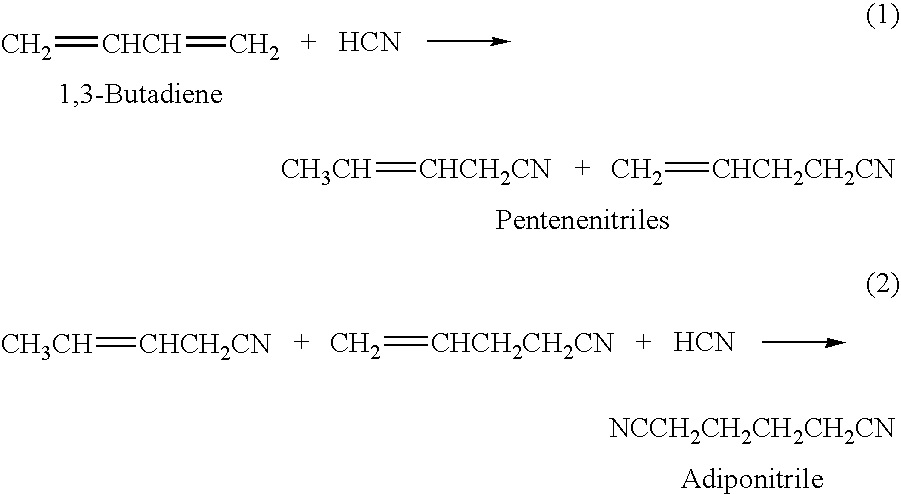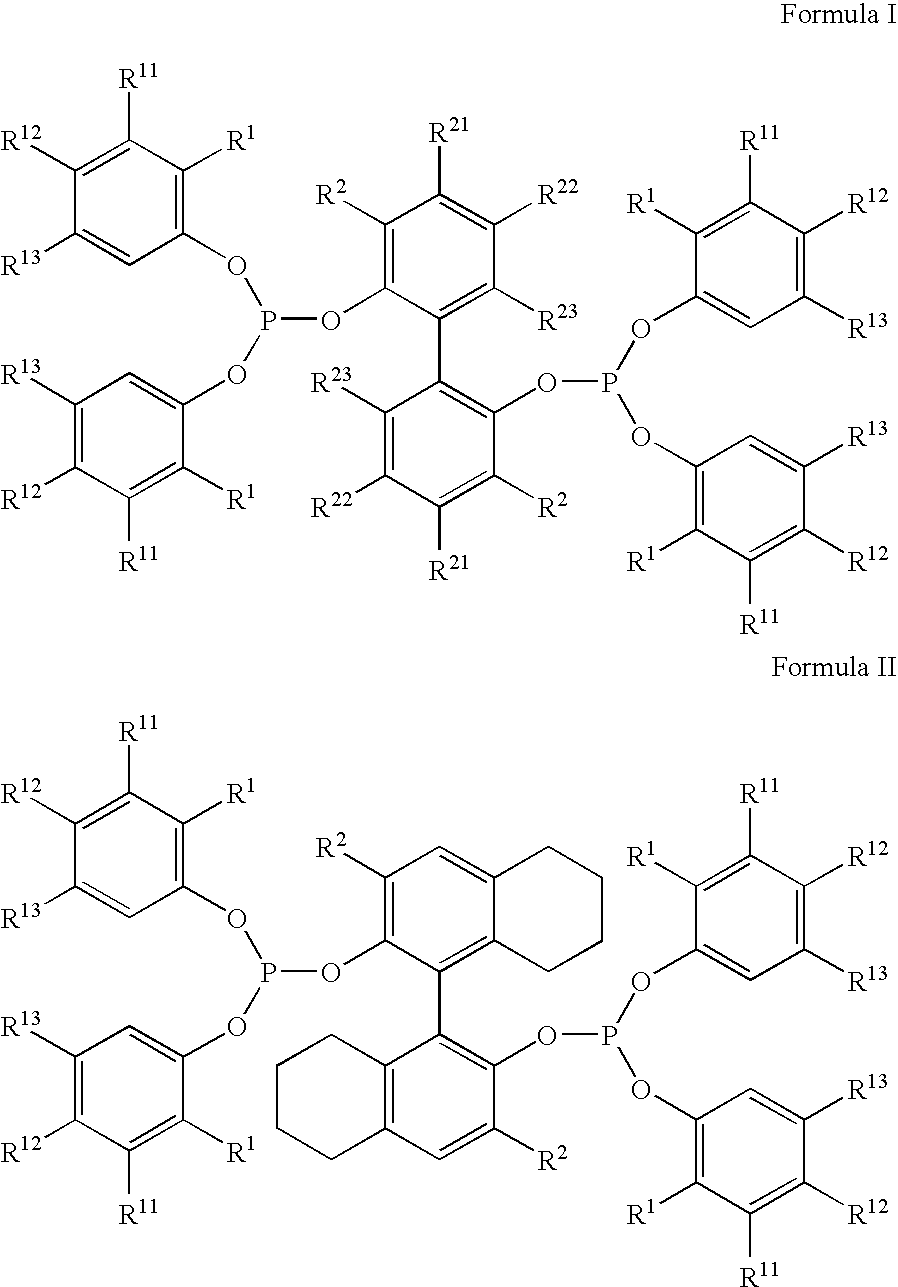Hydrocyanation process with reduced yield losses
a technology of yield loss and hydrogen cyanide, which is applied in the field of hydrocyanation, can solve the problems of undesirable 2pn production and detriment to catalyst efficiency, and achieve the effects of less process equipment, reduced cost, and reduced yield loss
- Summary
- Abstract
- Description
- Claims
- Application Information
AI Technical Summary
Benefits of technology
Problems solved by technology
Method used
Image
Examples
example 1
[0173]The inventive continuous hydrocyanation process was demonstrated using Ligand “A,” shown below, and FeCl2 as the Lewis acid promoter.
[0174]
Target reaction rate=1.6×10−4 moles HCN / liter-second
Temperature=50° C.
mol % 2PN feed=12.8%
The target feed rates of the reaction components were as follows.
[0175]
ReagentFeed Rate, g / hrHCNa0.293,4PN (3PN + 4PN)1.012PN0.15Ni catalyst, calculated as Ni metal0.0010Total Ligandb0.029FeCl2 promoter0.0015Notes:aHCN excluding PN solvent.bMixture of Ligand “A” and corresponding monodentate phosphites as described above.
[0176]The overall feed molar ratio of 2PN to all unsaturated nitriles was about 0.13 and the overall feed molar ratio of HCN to all unsaturated nitriles was about 0.75.
[0177]The averaged GC analyses of reactor product samples taken from 92 to 100 hours from the inception of continuous flow indicated the following steady-state results.
[0178]
3,4PN Conversion 86%mol % DN's73.6%mol % 2PN product14.0%mol % 3PN product11.8%2PN Yield 1.5%Lin...
example 2
[0180]The inventive continuous hydrocyanation process was demonstrated using Ligand “A” and ZnCl2 as the Lewis acid promoter.
Target reaction rate=1.6×10−4 moles HCN / liter-second
Temperature=50° C.
mol % 2PN feed=20.6%
The target feed rates of the reaction components were as follows.
[0181]
ReagentFeed Rate, g / hrHCNa0.293,4PN (3PN + 4PN)0.942PN0.25Ni catalyst, calculated as Ni metal0.0013Total Ligandb0.027ZnCl2 promoter0.0020Notes:aHCN excluding PN solvent.bMixture of Ligand “A” and corresponding monodentate phosphites as described above.
[0182]The overall feed molar ratio of 2PN to all unsaturated nitrites was about 0.21 and the overall feed molar ratio of HCN to all unsaturated nitriles was about 0.70.
[0183]The averaged GC analyses of reactor product samples taken from 49 to 53 hours from the inception of continuous flow indicated the following steady-state results.
[0184]
3,4PN Conversion90.7%mol % DN's71.9%mol % 2PN product20.3%mol % 3PN product7.2%2PN Yield0.0%Linearity95.0%ADN Yield95....
example 3
[0192]The inventive continuous hydrocyanation process was demonstrated using Ligand “B,” shown below, and FeCl2 as the Lewis acid promoter.
[0193]
Target reaction rate=1.6×10−4 moles HCN / liter-second
Temperature=50° C.
mol % 2PN feed=15.4%
The target feed rates of the reaction components were as follows.
[0194]
ReagentFeed Rate, g / hrHCNa0.293,4PN (3PN + 4PN)0.952PN0.175Ni catalyst, calculated as Ni metal0.0013Total Ligandb0.029FeCl2 promoter0.0019Notes:aHCN excluding PN solvent.bMixture of Ligand “B” and corresponding monodentate phosphites as described above.
[0195]The overall feed molar ratio of 2PN to all unsaturated nitrites was about 0.15 and the overall feed molar ratio of HCN to all unsaturated nitrites was about 0.80.
[0196]The averaged GC analyses of reactor product samples taken from 69 to 78 hours from the inception of continuous flow indicated the following steady-state results.
[0197]
3,4PN Conversion92.3%mol % DN's77.4%mol % 2PN product15.6%mol % 3PN product6.4%2PN Yield0.3%Linea...
PUM
| Property | Measurement | Unit |
|---|---|---|
| feed molar ratio | aaaaa | aaaaa |
| temperature | aaaaa | aaaaa |
| temperature | aaaaa | aaaaa |
Abstract
Description
Claims
Application Information
 Login to View More
Login to View More - R&D
- Intellectual Property
- Life Sciences
- Materials
- Tech Scout
- Unparalleled Data Quality
- Higher Quality Content
- 60% Fewer Hallucinations
Browse by: Latest US Patents, China's latest patents, Technical Efficacy Thesaurus, Application Domain, Technology Topic, Popular Technical Reports.
© 2025 PatSnap. All rights reserved.Legal|Privacy policy|Modern Slavery Act Transparency Statement|Sitemap|About US| Contact US: help@patsnap.com



